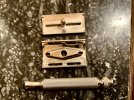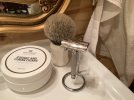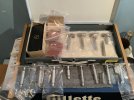You are using an out of date browser. It may not display this or other websites correctly.
You should upgrade or use an alternative browser.
You should upgrade or use an alternative browser.
Curious Journey of the British Gillette Tech
- Thread starter pjgh
- Start Date
- Messages
- 15,912
- Location
- Halifax, Republic of Yorkshire
- Thread Starter
- #35
Like there's such a thing as "too many Techs"? That's like saying "too many bottles of whisky" or "too many kittens". Puh! Splurge, man! Collect 'em all ... and collect backups ... and collect 'em again, but this time in their cases.
- Messages
- 5,609
- Location
- Cat-Pig Swamp
Can't shave with the case!Like there's such a thing as "too many Techs"? That's like saying "too many bottles of whisky" or "too many kittens". Puh! Splurge, man! Collect 'em all ... and collect backups ... and collect 'em again, but this time in their cases.
- Messages
- 752
- Location
- Lincolnshire
I have numerous Techs, including one yet to feature in Fat February (if I remember) - birth year, not cased, but boxed and very possibly intended to be on its way to the Vietnam War. Unrelated, but my question is - I have several British 40s Techs which are clearly 'fat handle' (I've weighed them) and flat bottomed (Achim pictures these per this thread). Is there any particular magic in describing them as fat handle or flat bottom and why choose one description over t'other?
Last edited:
- Messages
- 15,912
- Location
- Halifax, Republic of Yorkshire
- Thread Starter
- #38
Depends which part you ascribe the most value to, I guess? Dunno. I'd use both to describe the full razor if that's what I was doing (like "RFB New with open-ended ball-end handle" just to pick something not Tech) otherwise, I'd just talk about the working end of it - the head.
One point of interest is that British fat handles and American fat handles are different. The American ones are more "muffin topped" ... yeah, like the people. Canadian fat handle are often paired with the British style handles but I have seen many examples with the American style.
One point of interest is that British fat handles and American fat handles are different. The American ones are more "muffin topped" ... yeah, like the people. Canadian fat handle are often paired with the British style handles but I have seen many examples with the American style.
- Messages
- 27
Like there's such a thing as "too many Techs"? That's like saying "too many bottles of whisky" or "too many kittens". Puh! Splurge, man! Collect 'em all ... and collect backups ... and collect 'em again, but this time in their cases.
Well, I like both whiskey and cats. And razor cases. Backups are always sensible. I guess I’m hosed eh?
- Messages
- 27
So I went with a Tech shave today. I thought it fitting to ‘go British’ and selected a 50s Brit Ball End. But loading the blade I recalled the comments on the ‘small pins’ on the brit cap. So have I a Frankenrazor? It seems like this combination is wrong and must represent a mix up? Handy info you have created allowing me to discover this.




- Messages
- 5,609
- Location
- Cat-Pig Swamp
If it's the "normal" diamond baseplate with a fat handle I just call it a "fat handle Tech", if it's the unique Brit baseplate I would say it was a flat bottom Brit with a fat handle.I have numerous Techs, including one yet to feature in Fat February (if I remember) - birth year, not cased, but boxed and very possibly intended to be on its way to the Vietnam War. Unrelated, but my question is - I have several British 40s Techs which are clearly 'fat handle' (I've weighed them) and flat bottomed (Achim pictures these per this thread). Is there any particular magic in describing them as fat handle or flat bottom and why choose one description over t'other?
- Messages
- 5,609
- Location
- Cat-Pig Swamp
I've seen that cap on many Tech razors, and I've said often that there is no correct group of parts that make a Tech. What was available in the parts bins at the time would be used as long as it worked, if it fits it ships.So I went with a Tech shave today. I thought it fitting to ‘go British’ and selected a 50s Brit Ball End. But loading the blade I recalled the comments on the ‘small pins’ on the brit cap. So have I a Frankenrazor? It seems like this combination is wrong and must represent a mix up? Handy info you have created allowing me to discover this.
View attachment 117098
View attachment 117099
- Messages
- 15,912
- Location
- Halifax, Republic of Yorkshire
- Thread Starter
- #43
You might want to cross-check against this @Pogonaut
 www.theshavingroom.co.uk
www.theshavingroom.co.uk
Apologies, by "Long Slot" the second column, I really mean "Long Pin" (as in full length pin) like you're showing here. You can see that during the 1950s, I've listed three British examples - one has the twin pin cap (the earliest) and the others the full pin cap.
I have an inkling that the etching or stamping is the key here - once etched, certainly with the "Gillette" in a diamond like yours, it'll have the long pin. Earlier ones have just "Gillette" (no diamond surround) or are un-etched. The French one I mention is actually stamped in.

Left-most and second left-most show no and word only etching and over on the far right, there's the stamped one. So, those two on the left are twin pin and those two over on the right are long pin. Also long pin are the two in the middle with the full etch, the gold one Argentine and the chromed one American.
Yeah, checking through my master list (I have over 50 Techs, some in the loft) I can see a clear pattern that once the etch got beyond the mere "Gillette" word, the pin length settles on the long pin for British Techs ... as per the American Tech. So, I suppose the picture on page one could be better with two additional rows should first a British long pin and finally the American long pin (B) as the final destination. I'll re-do the picture some time (but don't hold your breath) as I was annoyed with the American long pin (B) being upside down.
Gillette Tech Head Weights
the MIC tech head weighs 11g total, which could equal the 8+2g of the Sterling (bearing in mind the precision of kitchen scales). I have two versions of Rapira Tech-style razors (one scarily aggressive, one merely assertive), both of which weigh 16g. Not sure that's helpful, but it's nice to...
Apologies, by "Long Slot" the second column, I really mean "Long Pin" (as in full length pin) like you're showing here. You can see that during the 1950s, I've listed three British examples - one has the twin pin cap (the earliest) and the others the full pin cap.
I have an inkling that the etching or stamping is the key here - once etched, certainly with the "Gillette" in a diamond like yours, it'll have the long pin. Earlier ones have just "Gillette" (no diamond surround) or are un-etched. The French one I mention is actually stamped in.
Left-most and second left-most show no and word only etching and over on the far right, there's the stamped one. So, those two on the left are twin pin and those two over on the right are long pin. Also long pin are the two in the middle with the full etch, the gold one Argentine and the chromed one American.
Yeah, checking through my master list (I have over 50 Techs, some in the loft) I can see a clear pattern that once the etch got beyond the mere "Gillette" word, the pin length settles on the long pin for British Techs ... as per the American Tech. So, I suppose the picture on page one could be better with two additional rows should first a British long pin and finally the American long pin (B) as the final destination. I'll re-do the picture some time (but don't hold your breath) as I was annoyed with the American long pin (B) being upside down.
- Messages
- 15,912
- Location
- Halifax, Republic of Yorkshire
- Messages
- 5,609
- Location
- Cat-Pig Swamp
The New and the oval slot '50s Tech share the same cap.
- Messages
- 27
You might want to cross-check against this @Pogonaut
Gillette Tech Head Weights
the MIC tech head weighs 11g total, which could equal the 8+2g of the Sterling (bearing in mind the precision of kitchen scales). I have two versions of Rapira Tech-style razors (one scarily aggressive, one merely assertive), both of which weigh 16g. Not sure that's helpful, but it's nice to...www.theshavingroom.co.uk
Apologies, by "Long Slot" the second column, I really mean "Long Pin" (as in full length pin) like you're showing here. You can see that during the 1950s, I've listed three British examples - one has the twin pin cap (the earliest) and the others the full pin cap.
I have an inkling that the etching or stamping is the key here - once etched, certainly with the "Gillette" in a diamond like yours, it'll have the long pin. Earlier ones have just "Gillette" (no diamond surround) or are un-etched. The French one I mention is actually stamped in.

Left-most and second left-most show no and word only etching and over on the far right, there's the stamped one. So, those two on the left are twin pin and those two over on the right are long pin. Also long pin are the two in the middle with the full etch, the gold one Argentine and the chromed one American.
Yeah, checking through my master list (I have over 50 Techs, some in the loft) I can see a clear pattern that once the etch got beyond the mere "Gillette" word, the pin length settles on the long pin for British Techs ... as per the American Tech. So, I suppose the picture on page one could be better with two additional rows should first a British long pin and finally the American long pin (B) as the final destination. I'll re-do the picture some time (but don't hold your breath) as I was annoyed with the American long pin (B) being upside down.
Got it! Thanks. Your logic on these seems sound so I’m going with your identification plan. It is really helpful for sorting through the development of these razors. Well done! So not a Frankenrazor, and a strategy for making good sense of my pile.
Now only to find find one of……and one of….….

